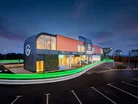GRIDSERVE’s expansion greens the nation's electric vehicles

In anticipation of our EV Magazine LIVE event, we caught up with one of our speakers— Sam Clarke, Chief Vehicle Officer at GRIDSERVE Sustainable Energy Limited—at the company’s second electric vehicle (EV) forecourt, based in Norwich, UK.
Aside from driving leasable EVs and checking out the company’s forecourt setup, Clark talks about the journey of the company to-date and provides more insight into future electrification plans.
Tell us more about your role and experience with EVs
I've been an EV driver for a long time, and part of my role within GRIDSERVE is to electrify the nation. That’s what our CEO Toddington Harper says.
Our team looks at all sorts of things EV-related, whether that be through releasing provision of the business or how fleets are going to access our network going forward.
Could you explain why GRIDSERVE is more than just a charging forecourt operator, and its work in sustainable energy?
The sustainable energy side is much wider than just the forecourts. We have what we call a ‘sun-to-wheel’ logic—a play on the old phraseology of ‘well-to-wheel’ about digging up oil, refining it, transporting it, supplying it to petrol stations, and so on.
We're still harvesting sunlight; it's just that we're not waiting 250 million years to dig it up. We're taking it from the sky on day one. Our energy source is the sun, our ‘oil refinery’ is battery storage, our ‘petrol station’ is an electric forecourt (or part of the wider electric highway infrastructure), and our vehicles are still vehicles but without tailpipes.
So we very much look at generation, distribution, and consumption of energy through the whole ecosystem.
How does GRIDSERVE select a site for an electric forecourt?
We've got an entire data team that looks into that. There are lots of different metrics that we need to consider. One of them is power, so we need to make sure we're able to get the right power to that location, or, if power is restricted, then how do we generate it locally?
We also look at the local demographic, the footfall of traffic, the distance from the main roads, the current market base within the area for EVs generally, and obviously the other charger types in the area. So, by virtue of Norwich, we've doubled the amount of charging provision in the entire area.
What shift in consumer mindset have you seen as they attend a forecourt like the one in Norwich?
I think EV drivers are attuned to the charging requirements and that it takes a little bit longer than when you are filling a car with petrol. Sites like this provide a number of different amenities that people can utilise while charging, so it's not just a case of the time it takes to charge, but involves grabbing a coffee, checking your emails, using facilities, having a rest, even if you're on a long journey. So there are lots of other things that can be done while charging.
Plus, we've got so much power here, and we can charge vehicles so quickly, that it becomes secondary to whatever it is that you are already doing here. We're trying to make sure that, across all of our sites, you’re not just charging but doing other meaningful things at the same time.
How have partners supported the company on this journey of building EV forecourts?
There are hundreds of companies that we've had to work with in order to deliver what we've already produced. Whether it be the companies that we work with to procure the solar panels, the land for our sites, and then the battery storage and the arbitrage and the trading on the grid, the construction companies that assist in building these. There's a huge complex ecosystem required in the background. We're delighted at the progress that we've made so far.
What developments are taking place at the moment to further the GRIDSERVE network?
Well it's not just the forecourts, it's also the wider electric highway.
So we procured that network in the summer of last year and, since then, we've upgraded the entire network across the whole country to put in new chargers and facilitate charging for 85% of the service stations in the UK. In addition to the forecourts, we're also building out those locations as well as more super hubs, which will house 6 to 12 high-powered DC chargers as well.
Our rollout is largely separated by three prongs. One is to continually upgrade the service station provisions while putting in more hubs at those sites, but also in additional sites, too, on top of building a number of forecourts.
The next one will be built at the South Terminal of Gatwick Airport next year, making it the first EV forecourt to be positioned inside an international airport. So we're very excited about getting that one off the ground as well.

